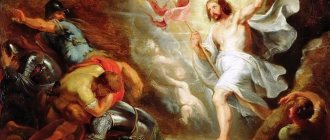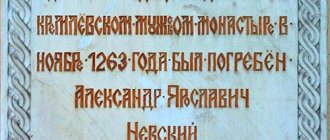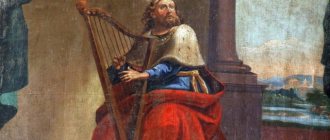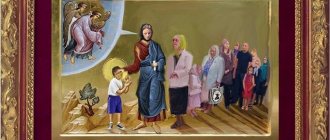This article is more likely not even a bomb, but a volcano. It was taken from another site. The opinions expressed here are not fully supported by facts. For example, it is not at all clear where this name - Radomir - comes from. The name is good, but how was it established that it was him. But about the earthquake and solar eclipse at the hour of Jesus’ death - there are already scientific references here.
And the date of his crucifixion is then clearly determined - February 16, 1086 . Whether to agree or not, whether to accept, is your choice.
And also for believers, I want to make a reservation - no one here says that there is no God, that rules (commandments) are not needed, but what are religions for?...Did Jesus ask or demand that people make an Idol out of him....
Again the struggle between the Dark and Light forces
We know practically nothing about those heroes who, throughout all these dark thousands of years, fought the Dark Forces without sparing their bellies. We are talking about the White Hierarchs, whose names have been carefully erased from our history, and all their deeds and exploits are shamelessly distorted and appropriated by parasites. Now we have become aware of the truth about Radomir (Jesus Christ), about his real parents, his wife - Mary Magdalene, about his brother, children, grandchildren...
Personality, life and struggle of Radomir
- the white Hierarch, whom we know today under the name
Jesus Christ
- is, apparently, one of the most hidden secrets of the parasitic system striving for world domination on our planet.
The parasites launched a decisive attack on the Slavic-Aryan Empire about a thousand years ago, on the eve and with the onset of a natural phenomenon known to us as the Night of Svarog. For the first time, the physical essence of this phenomenon was revealed by academician Nikolai Levashov in the article “The Last Night of Svarog” in 2006. This last Night lasted about 1000 years, ending in 1996. Related publication: The origins of hostility between Sunnis and Shiites
But what do we know about the historical Jesus?
Foreign scientists have been concerned about this issue for quite some time. Unfortunately, not much has been written on this topic in Russian. Book “Jesus. Historical investigation” by Latynina, built on scandalous and unreliable facts, does not count. Gleb Yastrebov’s study, “Who Was Jesus of Nazareth,” is much more objective and scientific, and among foreign sources, the key work is considered to be the work “Jesus” by David Flusser.
In turn, we, citing this in this article, relied on books, as well as public lectures by the famous religious scholar, candidate of cultural studies Konstantin Mikhailov
Relatives or cousins?
The family had to be large, at least Jewish traditions imply that there should be many children. The presence of brothers and sisters is also indicated in the Gospel. In the ancient Gospel of Mark there is mention of brother James, Joseph, Judas, Simon and at least two sisters. This is exactly what Protestants believe. But within the framework of the Catholic tradition, those listed are considered to be cousins. In Orthodoxy it is more complicated: the established point of view is that these are Joseph’s children from his first marriage, before he married Mary. It turns out that, according to Orthodox beliefs, Joseph was significantly older than Mary. Moreover, religious scholars agree with this. After all, from the texts of the Gospel it is clear that by the time Jesus began to preach, he had a family tragedy. The evangelists mention brothers, sisters and a mother, but do not mention a father, which perhaps suggests that Joseph had already died by that time.
Mysterious proto-source Q
There is another source that no one has ever seen, but nevertheless, it was possible to reconstruct it. When researchers compared the Gospels of Matthew, Luke and Mark, they discovered something interesting. The Gospels of Matthew and Luke contain common episodes that are not found in the older Gospel of Mark itself. These are very important episodes, for example the Sermon on the Mount. In the Gospel of Matthew it begins with the words: “Blessed are the poor in spirit for theirs is the kingdom of heaven.” The Gospel of Luke is a little different: “Blessed are the poor for theirs is the kingdom of heaven.” It seems like this, but not that. Where did the spirit go?
In general, there were enough examples to understand: Matthew and Luke relied on a certain Proto-Gospel. Perhaps the text was memorized and transmitted orally. This is the reason for the discrepancy.
The Gospel of Mark, the mysterious proto-gospel Q, and the Epistle of the Apostle Paul are the three pillars on which the study of the historical Jesus stands.
It is curious that already in the twentieth century, scientists managed to discover the Gospel of Thomas, the first versions of which, apparently, were created in the 70-80s of the 1st century, that is, around the same time as the Gospel of Mark. This is also a very interesting Gospel to study, despite the fact that it does not contain a description of the biography of Jesus: mainly sermons and speeches.
Jesus is a real historical figure
After spending many years of research, scientists have come to the conclusion that Jesus really existed. It’s funny, all believers already know about this. But scientists are scientists because they need to doubt and prove everything. But in the case of Jesus, more evidence is required. Such a paradox. Scientists know an order of magnitude less about 99 percent of the characters of antiquity than about Jesus, but at the same time they do not have the slightest doubt that they existed. For example, no one would think of doubting the existence of Pythagoras, although the only early biography of Pythagoras was written centuries after his death.
“If it were absolutely any historical figure, we would say, fathers, for a character of the first century we have hundreds of pages of documents, but scientists will always argue about Jesus precisely because it is Jesus,” religious scholar Konstantin Mikhailov explained incomprehensibly.
Was the historical Christ born before Christmas?
The unknown continues. It seems that everyone knows when Jesus was born: after all, we count our era from the Nativity of Christ. However, we do not know the exact date. Evangelists write that Jesus was born during the reign of Herod the Great. Then, taking into account that Herod died in 4 BC, we get that Jesus was born before the Nativity of Christ, oddly enough. The Gospel also reports that Jesus was born during the Roman census of Judea. But the only census that is suitable in time dates back to 5-6 AD. Then it turns out that Jesus was born after Christmas.
True, historians still suggest that Jesus was born during the reign of Herod the Great, that is, no later than 4 years BC.
Now regarding the date of birth. It’s also difficult with it, because scientists are not sure that it is December 24-25, as is commonly believed. It is known that early Christians celebrated the birth of Jesus in April and May, and subsequently adopted Roman dates: at the end of December the Romans celebrated the key holiday of the cult of the Invincible Sun. Christians also liked the idea of the Invincible Light triumphing over darkness, so, most likely, they tied the birth of Jesus to these days.
The same with the end of earthly life. We know that this is the middle of Passover, the middle of the month of Nissan, but how long Jesus lived is a mystery. It seems to be really 33 years, but nowhere in the New Testament does it say this.
Excellent speaker
At the age of about thirty, Jesus begins to preach sermons. And here the most ardent skeptic will not be able to refute: he was an excellent speaker, attracting up to five thousand people to his sermons. At that time, it was the same as putting together an “Olympic”: taking into account that there were no means of amplifying the sound and more people simply would not have heard anything. In addition, Jesus was also an outstanding healer.
The critical approach of scientists assumes that all miracles need to be explained or refuted. However, the explanation of some miracles is no less beautiful than the miracles themselves. An example is when Jesus feeds a large crowd of people gathered with five loaves of bread and two fish. Religious scholars believe that we are witnessing a “miracle of human generosity”: there was a long sermon, everyone was tired, and Jesus took out his food and shared it with the people. At that moment, the others, touched by his action, remembered that they had brought food with them for the picnic and also began to share. The writer Varlam Shalamov interpreted the miracle approximately in this vein.
Who first wrote about Jesus
We do not have texts from Jesus himself. Therefore, researchers rely on documents written after the crucifixion. The earliest is the letter of the Apostle Paul, created 30 years later. There is quite a bit of biographical information in this source, because the Apostle Paul is addressing members of the Christian community, those who already know everything well.
Image of Christ on the crucifixion in a Catholic church.
The second source is the New Testament. As you know, it includes four Gospels, the earliest of which is from Mark, created around 60-70 AD. Ten years later, the Gospel of Matthew was written. Another decade later - from Luke. Historians rely on them primarily. The most recent, the Gospel of John, was created 70 years after the crucifixion. Therefore, it is classified as a second-line source.
Not a carpenter, but a mason
Historians do not argue with the fact that Jesus’ parents were named Joseph and Mary, that Christ was born and raised, most likely, in Nazareth, although in later life he lived in the city of Capernaum, because this city was the center of his preaching. The family was simple and not very wealthy. But religious scholars do not really agree with the fact that Joseph was a carpenter. Most likely he was a mason. After all, the Greek term for Joseph's profession means carpenter, joiner, and metal worker. And given that the family lived not in a wooded area, but in a desert area, it could hardly be assumed that the carpenter had a lot of work.
Immaculate Conception
No one sets out to refute or prove the idea of the virgin birth. However, neither the Evangelist Mark, nor Paul, nor even John write anything about this, and the Apostle Paul says that Jesus was the seed of David according to the flesh, that is, in the male line he descended from King David. In addition, as researchers say, the Jews did not have the idea of vicious conception at all.
“Most likely, this idea arose later, in the 60-70s of the first century, when the bulk of the early Christian community began to be formed by former pagans,” says the religious scholar. “They understood that unusual heroes must be born in unusual ways. For example, they talked about the immaculate conception of Plato and Octavian Augustus, the emperor during whom Christ was born. Moreover, August’s parents were well known.









